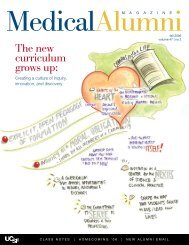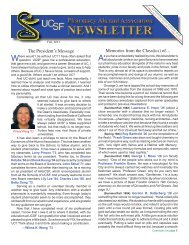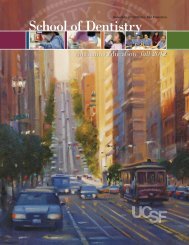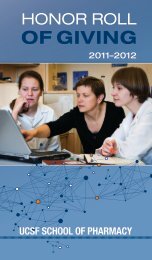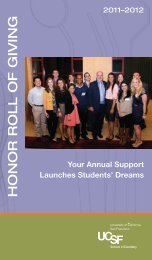here - UCSF Alumni
here - UCSF Alumni
here - UCSF Alumni
Create successful ePaper yourself
Turn your PDF publications into a flip-book with our unique Google optimized e-Paper software.
IMPROVING PATIENT SAFETY“First,Do NoHarm”By Elizabeth Chur“ Until 10 years ago, wewere taught in the healthprofessions to believethat errors were manifestationsof bad, careless people,”says Robert Wachter, MD,chief of the Division of HospitalMedicine at <strong>UCSF</strong>. “We nowknow that most errors are madeby competent, well-trained,caring people trying to becareful, and the errors simplydemonstrate they are human.”In 1999, an Institute of Medicinereport entitled “To Err is Human:Building a Safer Health System” sentshockwaves through the medicalcommunity. It estimated that up to98,000 people died each year due tomedical errors.Wachter has led <strong>UCSF</strong>’s efforts toimprove patient safety. In twobestselling books, Internal Bleeding:The Truth Behind America’s TerrifyingEpidemic of Medical Mistakes, andUnderstanding Patient Safety, Wachterchampions a new perspective. Insteadof blaming individuals, he argues forsystemic changes to prevent mistakesfrom happening in the first place.“The most common causes ofmedical mistakes are communicationlapses – information didn’t make itfrom place A to place B correctly, orfrom person A to person B correctly,”says Wachter. Common mistakesinclude giving a patient the wrongdrug or dose, performing surgery onthe wrong patient or body part, ormaking the wrong diagnosis.One example of how bettercommunication has increased patientsafety at <strong>UCSF</strong> is the way medicalresidents entrust their patients to otherphysicians at the end of their shifts –the handoff process.Previously, this process washaphazard. Residents would spendlots of time hunting down keyinformation – vital signs, lab reportsand medication lists. Arpana Vidyarthi,MD, who arrived at <strong>UCSF</strong> as a hospitalmedicine fellow in 2002, says, “Idistinctly remember seeing residentsthrow down a stack of index cards,two inches thick, with information for50 patients hand-scribbled on them,and say to the next person, ‘T<strong>here</strong>’snothing to do.’ Given how sick many ofour patients are, this would cause meanxiety as I recognized the potentialfor harm during the cross-coverage.”In 2003, the Accreditation Councilfor Graduate Medical Educationlimited residents to an 80-hourworkweek and maximum 30-hourshifts. Vidyarthi, who is now director ofpatient safety and quality programs forthe Dean’s Office of Graduate MedicalEducation, says, “The reductions inwork hours were designed to reduceerrors caused by fatigue.” However,this has resulted in more frequenthandoffs among residents, which alsoincreases the risk of communicationerrors.With the assistance of <strong>UCSF</strong>Medical Center, Vidyarthi andJonathan Carter, MD (then a <strong>UCSF</strong>surgery resident) developed acomputer-based system dubbedSynopSIS. It provides a snapshot ofthe most important informationresidents need to know duringhandoffs, including the patient’sphysical location and list ofmedications, why the patient wasadmitted, and anticipated problems.Drawing on his or her understandingof each patient’s case, the outgoingresident prepares a list of “if-then”statements: if the patient develops afever, then test for infection and startcertain antibiotics; if the patient4 | fall 2009




